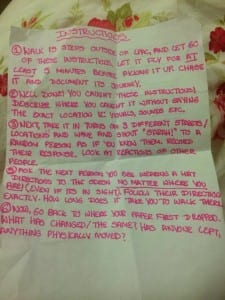- In this weeks session we discussed Carl Lavery’s theory he has for Site Specific Performance.
- Talked in to detail about the ’25 instructions’ technique that he spoke of in his book.
- The instructions gave students learning or educators teaching site specific performance the structure or stimulus to create their pieces of art/ performance.
- After reviewing Lavery’s instructions, we were asked to split of into groups of three and create our own set of instructions that we thought would be appropriate to create the same style of effect that Lavery did.
- We were given 30 minutes for this task, once we had done we returned to the studio and we were then asked to exchange our instructions with another groups.
- We had to take the new found instructions and execute them within the city centre.
- Documenting and collecting physical and visual evidence to defend our work. We collected object from the path side when we were instructed to do so. For example I had collected a stone from near a bridge that was under construction and a collection of moss. (Pictured below)
- We also individually recorded the sounds of the street for 60 seconds.
- One instruction we followed was to find the first brunette man we could see and follow him for exactly 100 steps.
- This instruction made me feel uncomfortable completing this task. The way we were behaving, being aware of what we were doing at the other participant had no knowledge. This made me aware of the tacit agreements created to maintain a controlled and safe society. We were purposely breaking these set of ‘rules’. This added to the already tense atmosphere that my group and I had created, because we all knew we were not sticking to the expectation.
- “Stop dead for 3 minutes” This instruction doesn’t sound like a very hard or a pressuring thing to do. Due to the previous instruction being to set a stopwatch for 60 seconds and power walk in any direction, we ended up in front of the train line barriers just before they were due to come up and let the pedestrians cross again. This created yet another socially testing technique because we were stood in the walking space of everyone wanting to pass through to the other side. This instruction also heightened the factor of time because in the city everyday life seems sped up this caused by the hustle and bustle of the career men and women. It didn’t help that we were doing this experimental technique during dinner hours.
- Although we didn’t create these set of instructions we all discussed afterwards that we couldn’t help but feel responsible for the discomfort we had made the participants experience.
- Reactions we recorded from the members of the public were varied but not largely. Many people were aggravated by our actions and we continuously received many disappointed and angered facial expressions.
. IDEAS AFTER THIS SESSION:
. Speakers Corner – Create awkward list of instructions to perform within that space to obstruct people continue for 2 hours and record the actions of every passing member.
. Old Market Place – Nostalgia – Replay old sayings and callings that would have been spoken out whilst stood on heightened levels – costume and décor surrounding is going to be associated with the era that the market first opened – INFLATION – How things have changed from that era to now – The heightened prices and heightened expectations of generations – compare.
. Removed the Brayford River Idea – To much pressure on the participating audience for them to actually acknowledge me being there – not a guarantee.
. NEW IDEA – Lincoln in time / Lincoln city one moment – staring at the detail on a building opposite the train station waiting to go home – Paint large ply board pieces of wood with patterns of the city that would have been accommodated during the era that the cathedral was first built –
- 1141 – Cathedral suffered a fire that destroyed most of its structure.
- 15th April, 1185 – Cathedral suffered an earthquake the biggest ever recorded to ever hit England.
. Whilst painting these patterns play recording of ‘Great Tom’ the biggest bell that ever rung in the cathedral towers. “It may no longer be the biggest, but in the hearts of many it certainly remains the best”
KEY WORDS
. SUPERMODERNINITY – Bombarded by imaging/ Modern Life
. NON-PLACES – Short period resting positions – Airports/ Carparks/ Train stations/ etc.
. PLACES – Has a cultural meaning to the community and society alike.
KEY PRACTIONTIONERS
. CARL LAVERY






